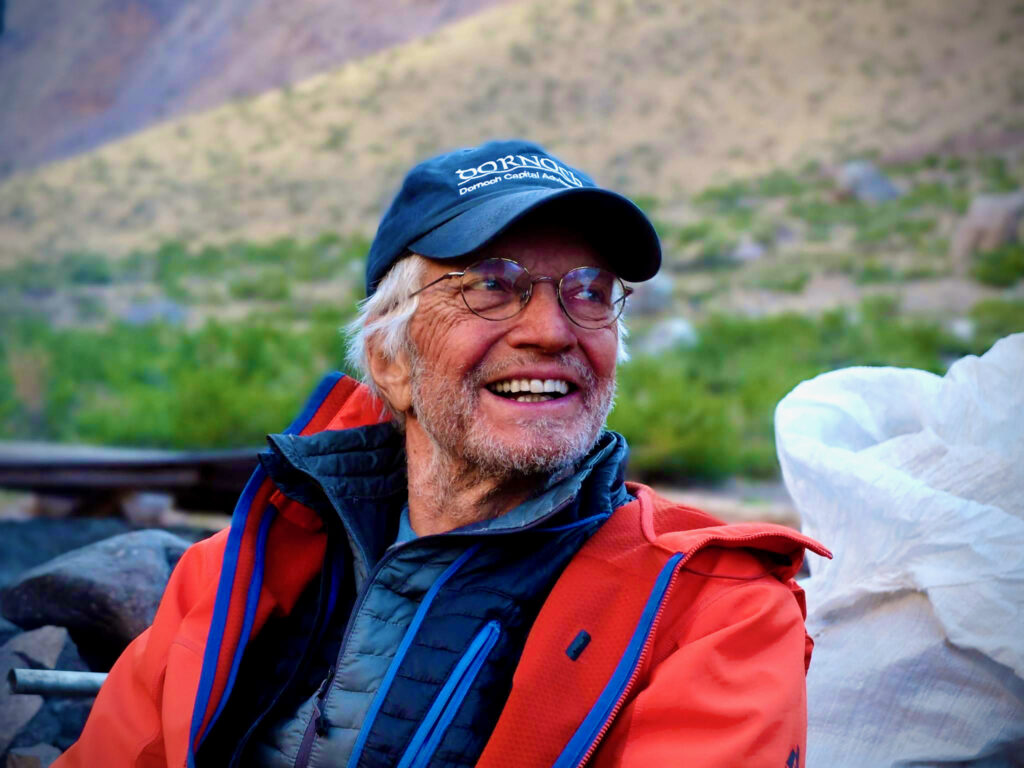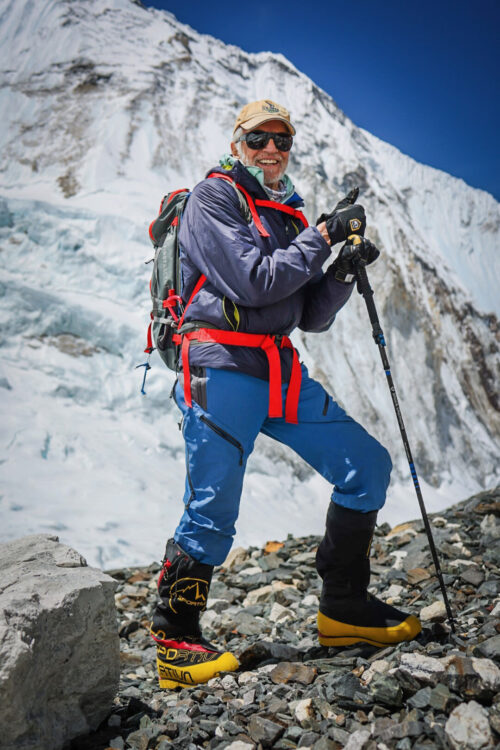
By David A. F. Sweet
Back in 2013, Art Muir was nearing the end of a 35-year career as a transactional attorney at McGuireWoods, LLP in Chicago. At 68, he was ready for a retirement full of golf, platform tennis and grandchildren.
Then, a longtime friend of his named Jim Daverman called and invited him to climb some volcanoes in Ecuador. Though Muir had ascended mountains such as Pikes Peak in his native Colorado during his youth and a few others afterwards — including a trek to the north side of Mount Everest in 1990 and an attempt to climb Denali (formerly Mount McKinley) that stopped short of the summit in 1991 — those expeditions had occurred more than two decades previously. In mountaineering, that’s a lifetime.

“I discovered that volcanoes are steep, cold, snowy and high,” Art Muir said about climbing his first one in Ecuador in 2013.
“I said, ‘Jim, I’m an attorney. All I can really do is hit speed dial,’” Muir recalled. “I said to my wife (Leslie), ‘Why would I want to climb volcanoes?’ Leslie replied, ‘Because he’s your friend.’”
Thus began an odyssey that has taken the Northwestern University law-school alumnus to the top of the world – Mount Everest, where in May 2021 at 75 he became the oldest American ever to reach the summit – and this month to Mount Vinson in Antarctica, which will be Muir’s sixth leg of the famous Seven Summits.
“I always sign up for these things, then I have misgivings, then each one always develops into the most fabulous thing in the world,” said Muir, wearing a blue Patagonia vest over a T-shirt during a lunch of Thai food.
The misgivings are apparent in a picture Muir shows of a room full of bags before his Antarctica excursion.
“Packing is the worst part of the trips. It takes much longer than you think,” said the septuagenarian, who recently landed on an ice runway with his companions in Antarctica before embarking toward the South Pole while dragging a sled. “There’s so much clothing and gear to bring along in these environments. I have a checklist that’s 13 pages long.”
Muir’s interest in mountaineering has been lifelong. As a boy, his father gave him a book about Maurice Herzog, a French mountain climber who ended up losing many fingers and toes leading the first successful ascent of an 8,000-meter peak, Annapurna, in 1950. That story fired the youngster’s imagination. As a teenager, Muir was an Eagle Scout, which give him a great appreciation of the outdoor world.
“I learned outdoor skills that I have carried with me my whole life,” he said. “The knowledge I gained from scouting includes woodcraft, knot tying, astronomy, a sensitivity to nature, awareness of the relationship between wild animals and ourselves, the cultivation of leadership skills at a young age and more.”
In Denver, famous mountaineer Barry Bishop spoke to his small private high school. Though Muir missed the talk, he heard all about it.
“Some things never lose their power – that visit was one of them,” he said.
Let’s return to 2013. There was Muir, the office-bound lawyer standing at the bottom of a volcano. How did this propel him to a decade of climbing when he’s collecting Social Security?
“I discovered that volcanoes are steep, cold, snowy and high,” he said. “But I watched how our two guides took these newbies through this process and got us ready to climb in this dangerous place. I was so impressed that they could take me — an ordinary dude — and get me into a place where I could never get in my life on my own. I was so impressed by their professionalism that I decided to do another one.”
A year later, his son, Charlie, climbed Mount Rainier in Washington. He asked his father to accompany him to Denali to see if this time he could reach the summit. In 1991, he had stopped at about 17,000 feet.
“It was really, really cold – 45 below zero,” Muir recalled. “My friend took his gloves off and realized he had frostbite. He said he had to pack it in.
“It was a perfectly blue-sky day. I saw a group I thought I could climb behind. Then I thought, at home I had three young kids. Maybe that’s not responsible. Reluctantly, I went down.”
But with his son, he reached the top of Denali in 2015 – and realized that he was smart to quit the climb years before.
“It’s a huge distance from high camp to the summit (20,310 feet), and you have to carry a pretty heavy pack,” Muir said. “I knew then how easily I could have died trying to summit by myself.”

“My mantra was once I got off the plane, I would not make one single mistake,” said Art Muir about his 2021 conquest of Mount Everest at age 75.
In 1990 as a trekker he climbed on the northern side of Mount Everest to 21,500 feet – right where the serious climbing begins. It was a shorter route than the better-known one on the south side, but he learned just how hard it was. In 2018, he hired a coach to help him prepare for a summit attempt on the south side — including the required crossing of the dangerous Khumbu Icefall.
“For the training, I said to my coach Scott Johnston, ‘I still want to have enough time and energy to play platform tennis and golf,’ Muir recalled. “Scott said, ‘You don’t understand. You’re going to Mount Everest. You could die.’ He told me I’d need another year to get ready. But I had already paid for it.”
During the 2019 expedition, Muir fell off a ladder and twisted his ankle, ending that effort.
“My coach was right. I wasn’t ready physically or mentally,” Muir said. “I didn’t have an idea of the scope of the mountain. I realized you can’t make any mistakes.”
Determined to return with a better effort, the pandemic hit, closing any opportunities in 2020. By 2021, after embracing a tough 500-hour-a-year training regimen — and despite a sore wrist and balky knee — Muir was ready.
Still, even the best climbers face challenges including – but not limited to — altitude sickness and avalanches. Mentally, climbers must understand that they are not involved in a race – climbing is more a matter of survival. More than 300 have died on Mount Everest.
“In 2021, my mantra was once I got off the plane, I would not make one single mistake,” Muir noted. “Every time I took a step, I tried to put my foot exactly where I wanted to put it. I thought about that thousands of times.
“On the final leg of my summit attempt, which takes several days, I was high on the mountain after climbing for almost nine hours. As I climbed over some rocks, I saw the final slope up to the top of Mount Everest for the first time. I was about an hour from the summit. I’m getting goose bumps thinking about it. I could see people standing on the top. I said to myself, ‘I know I’m going to do this.” It was a powerful moment — I knew I would get to the top.”
Once there, the third-oldest person in the world to reach the summit had little energy to enjoy the gorgeous view. He sat down for seven minutes – then started his descent.
“There was a lot of mental strain, and I’m thinking I’m only halfway,” said Muir, who pointed out more people die from exhaustion during the descent of Everest than the ascent (earlier that year, a climber sat down after summiting not far below the top and never got up again). “There’s a famous quote by renowned American climber Ed Viesturs – ‘Getting to the top is optional – getting down is mandatory.”’
Soon after arriving at the bottom, he discovered he was a celebrity. Muir was perplexed.
“There was all this press. I was thinking, ‘What is the big deal? I didn’t come close to dying,”’ said the mountaineer, who even appeared on The Today Show from Katmandu as his iPhone battery dwindled to almost zero during the video interview. “They kept talking about the age factor. I just came to this later in life. I wasn’t trying to set some kind of record.”

The adventurer wears the anorak that he took to Antarctica. “It’s never too late,” he said about his decade-long adventures.
Later that summer, Muir took a congratulatory call from one of his climbing heroes, Jim Whittaker, who in 1963, became the first American to reach the top of Mount Everest.
“That was one of the greatest days in my life,” Muir said. “It’s like taking a call from the President of the United States.”
Lest you think Muir is only a climber, consider these other expeditions since only last year: a 250-kilometer coast-to-coast traverse of Costa Rica via bike, hike, raft and kayak and heli-skiing in Northern British Columbia. And down in Antarctica for the first time, one can see how far he has come from his original vision of visiting the continent.
“I had always wanted to go to Antarctica — but in a ship, drinking some scotch and watching the penguins.”
The Sporting Life columnist David A. F. Sweet can be reached at dafsweet@aol.com.






